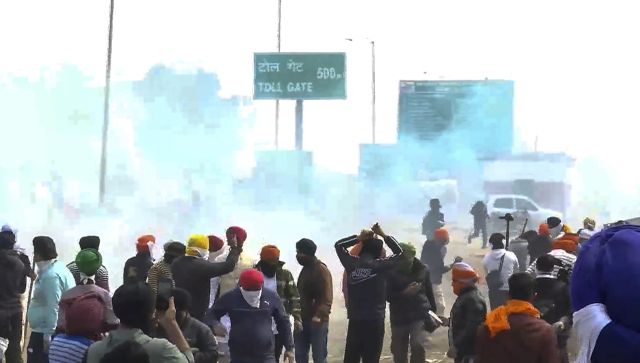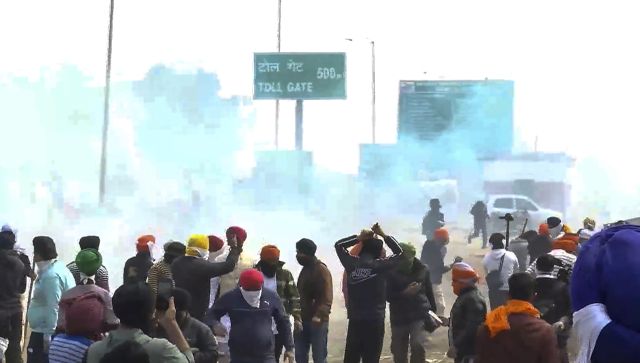By Tarique Anwar & Naresh Sharma
New Delhi: As temperature plunges to bone-chilling levels in the national capital, lakhs of homeless people are forced to take shelter on footpaths, under flyovers and even in public urinals because of the lack of night shelters. The Delhi government claims to have established 221 night shelters for homeless people with basic facilities such as blankets, bedding, clean drinking water, toilets, etc. It has also appealed to Delhiites to display “yeoman kindness” by donating blankets and warm clothes at night shelters and motivate the homeless to shift to the nearest night shelter.
Firstpost’s Tarique Anwar and Naresh Sharma did a reality check and ended up disappointed with the government’s claims. They found that the government’s efforts are at best cosmetic and a lot of homeless and poor are still battling the harsh Delhi winter.
All India Institute of Medical Science (AIIMS)
Time: 10 pm
Insufficient space in the AIIMS dharmashala (rest house) – it has 650 beds - has forced hundreds of families to spend night in the cold.
We found hundreds of patients and their attendants sitting huddled over makeshift stoves outside the gates of hospital to keep themselves warm and fit for next day’s treatment at India’s ‘premier’ hospital. Those who were lucky had found a place in a nearby shelter run by the hospital; the others spent their nights under the open sky on footpaths, bus stops and on the premises of the nearby metro station. As they stay on the roads, biding their time till the next appointment, many say they have no other option. They are too poor to afford a trip home and come back again.
For physically-challenged Amrinder, his wheelchair is his home. The 34-year-old had a breathing problem and came to Delhi from Patna for treatment at AIIMS. Doctors here told him that he will have to undergo a surgery. But before he could go back to his native place to arrange the amount required for operation, he suffered a paralysis attack. He is restricted to his wheelchair and has been living outside the hospital for the past three years, waiting for a date for his surgery.
“Doctor ne kaha ki mera operation hoga, lekin ab tak nahin hua. Hum log garib hain aur hamari koi nahin sunta. Main pure sharir se apang ho gaya hun lekin mujhe aaj tak operation ka date nahin mila." (Doctors suggested that should undergo a surgery. We are poor that is why nobody listens to us. Now, I am completely paralysed but still I have not got a date for the operation), he told Firstpost.
Slumped on his wheelchair, the man now begs for a living while awaiting treatment.
Lying under a polythene sheet on the road side is Ram Pravesh Yadav, a resident of Samastipur in Bihar, who came here on 6 May, 2014 with a tumour in his backbone. He said he was told by the hospital authorities that he will be subjected to a MRI test but his turn will come in 2016.
“When I requested for an early appointment as my pain was unbearable and I cannot even stand, the doctor asked me to go to a private hospital. I somehow managed Rs 9,000 and got the MRI test done from a private diagnostic centre. In January, I will undergo surgery,” he said adding that he is left with no option but to sleep in the open as he cannot afford private accommodation and the AIIMS night shelter has no vacancy.
In a corner of the metro premises, Raju Nishad from Malda in West Bengal lies shivering in the cold, hunched under a tattered blanket which provides little warmth. He has his four-year-old daughter with him for company. She is suffering from strength loss on her right hand. He has been waiting for a month for an appointment with a senior doctor.
Ravi Shankar, who came to Delhi a month back from Sagar in Madhya Pradesh, struggles to beat the cold at a bus stop every night. He has a tumour in his eye and will only undergo surgery after six months. “I cannot return home and come back after six months because I will be subjected to several tests and I am unable to bear the expenses of regular visits,” he said.
Rupanti Mishra of Dhaulpur in Rajasthan, whose husband is undergoing a treatment of spinal cord, has been camping in the city for the past five years. The duo has to face the harsh icy winters and the unbearable summer and their only refuge is a temporary plastic tent erected on road side.
It is a sad story, repeated each day. The Aam Aadmi Party (AAP) government had turned and modified abandoned Blue Line buses into night shelters for such homeless people. The step had provided relief to thousands of homeless living on the streets in the cold but after the AAP government resigned all the buses was removed because it was giving a “bad look” to the hospital.
Sarai Kale Khan Time: 12:25 am
This time of the year, most Delhiites struggle to keep warm, even in closed rooms. In Sarai Kale Khan, we saw a large number of people sleeping under the flyovers, out in the chilling cold without any proper clothing. Those having blankets were sleeping but many were half-awake and shivering as they had nothing for protection.
As we parked our car near the flyover and approached the people sleeping under the flyover, we were surrounded by many who mistook us as NGO representatives who had come to distribute blankets.
“Beta humlog is thandak men mar rahe hain…ek kambal aur kuch khane ko de do (My son! We are dying of cold. Please give us a blanket and something to eat),” said 45-year-old Komal, who belongs to Bhatinda in Punjab. She along with her two children has been living under the same flyover for the past five years.
Refusing to accept Delhi Lieutenant Governor Najeeb Jung’s appeal to use night shelters, majority of the homeless said the city’s roads are safer for them, than the government-aided night shelters.
“Most of the occupants of the shelter homes are drug addicts and alcoholics. How can I take my young girls to a place that houses drunken people?” asked Safeena, who calls city’s pavements her home.
“It is true that surviving in this freezing cold here is not easy but the only respite is we are safe here,” said the mother of three. When asked isn’t she afraid of anti-social elements, she replied with a smile, “Years of hardship has made me tough to face any untoward incident. It is not only the anti-social elements but the local police that disturb us. I am left with no option but to tackle them.”
Many of the homeless agreed that they will not hesitate to shift from the place if the government provided them with safe shelter homes, where they can sleep and keep their belongings.
Yamuna Bazaar, northeast Delhi Time: 1:30 am
Around 1,500 people, most of them rickshaw pullers and daily wage labourers, were sleeping under a flyover in this area. There is a permanent night shelter as well but it can accommodate a maximum of 210 people. The Rain-Basera of Delhi Urban Shelter Improvement Board is being managed by an NGO Prayas.
Bajrangi and his family, who sell toys outside famous Hanuman Mandir, have made the footpath near the temple their home. “We don’t have proper blankets. It gets very cold at night," Bajrangi said.
A basement near central Delhi’s Hanuman Mandir has been home to Ram Sagar Pandey for the past 25 years. He sells trinkets at the temple by day, and by night, he and his two daughters try to make do with the tiny space they have at its basement.
Explaining how difficult things are, he says, “This space gets flooded with water…. The cold is a bit too harsh here."
However, he adds that despite the cold and the lack of any amenities, he prefers the dungeon over government night shelters. “It is not possible to stay at those shelters at they are located far away. We cannot leave our things here and go to stay there. And even if we do, who is going to pay for the bus fare?” he asked.
People who live around the night shelters alleged that shelter caretakers charge Rs 10 for booking a place and a blanket.
“They throw us out of the shelters and say the shelter is full. But they take money from others to book blankets. People who can pay Rs 10 get a place to sleep,” complains Shankar who sleeps on a road-divider near Yamuna Bazar.
Shelter Home at Fatehpuri, Kashmiri Gate Time: 2 am
The night shelter being managed by the Society for Promotion of Youth and Masses (SYPM), an NGO that works for drug addicts, alcoholic and homeless, was cleaner and well-managed but overcrowded. As per the government’s instruction, it can house a maximum of 90 people at a time but when we visited a total of 270 people were sleeping.
Sanjay Ghosh, supervisor of the night shelter, said, “We cannot refuse entry to those who come here in search of safe place to sleep. Our priority is to protect people from this biting cold.”
He admitted that most of the occupants are either drug addicts or alcoholic. “Providing a shelter to homeless in winter season is not the solution to the problem. We give counselling to those who are alcoholic and drug addicts and send them to our rehabilitation centres,” he said.
Homeless people come here in different shifts. Those who work in the day rest here at night and vice versa. Interestingly, the big hall has a LCD television for the entertainment of the occupants. It also provides tea and snacks to the people in the morning.
ISBT shelter Time: 2:20 am
Because of its proximity to the inter-state bus terminus, the shelter was also over-crowded. All that people get here is a thin blanket, certainly not enough to fight this biting cold. But despite the poor infrastructure, many are just content to have a roof over their head.
Firstpost found hundreds of people sleeping on footpaths, under bridges and even in open grounds. For 1.5 lakh homeless people, Delhi just has 222 shelters, including tents, which can only accommodate 17,100 people at the most.


)




)
)
)
)
)
)
)
)